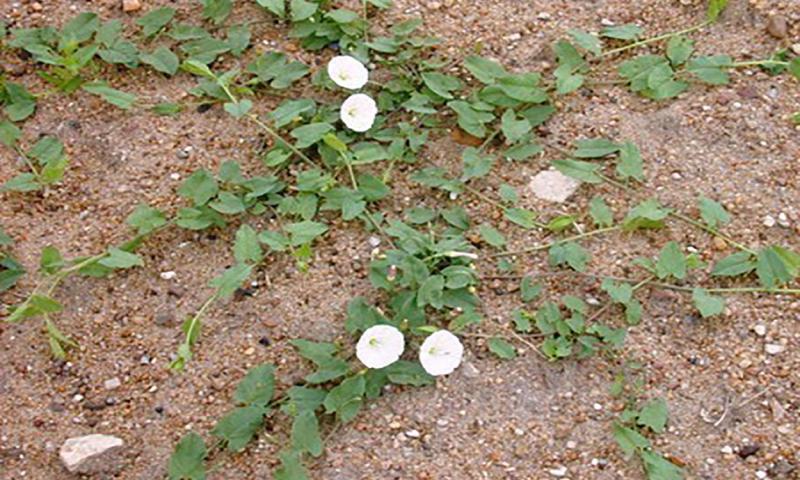
Originally written by Gared Shaffer, former SDSU Extension Weeds Field Specialist.
Field bindweed is one of the most-serious weed problems in South Dakota. It is currently listed as a locally noxious weed in the following counties: Bon Homme, Clark, Hughes, Lake, Stanley and Yankton. Field bindweed is also commonly called creeping jenny, small-flower bindweed, small bindweed and greenvine. It is a perennial, originally from Eurasia. Common flowering months range from June through September. It spreads through seed and rhizomes and has white-or-pink corolla flowers. The easiest way to tell field bindweed from hedge bindweed is the leaf shape. Field bindweed has leaves with pointed or blunt lobes with the blade being level to the petiole. Hedge bindweed has distinct basal lobes and blades are almost right angles to the petiole.
Management in Yards
Often the best practice for weed control in turf is through chemical means. There are organic weed control options, but not selective organic chemical options. All organic chemical options are non-selective, meaning they will suppress or kill any plant they come into contact with. Control of perennial weeds in turf can be difficult without the use of chemicals. Glyphosate is the best option to control a perennial species, like Field Bindweed, but it is not selective. The best selective chemical control for broadleaf weed control are products that include the combination of 2,4D+dicamba+MCPP, but a repeated application 10 to 15 days after first application may be required for 100% control. Products that contain only 2,4D; Triclopyr; or Quinclorac have been shown just to suppress field bindweed, but possibly not fully control it. It is best to apply herbicides in the fall following the first light frost. A non-chemical option would be hand pulling or digging out all plant and root material. Hand pulling may only be effective on a small infestation.
Management in Gardens
Field Bindweed control in gardens may be challenging. The most challenging part of field bindweed being present in gardens is that it may climb fences, tomato cages and other plants. Most gardeners do not want to use herbicides in their garden due to the potential for toxicity that may affect their vegetables. Tillage is a non-chemical option that may be taken. Tillage is not a good option for Field Bindweed control, because it may bring up weed seed that is then able to germinate and spread rhizomes that may produce more weeds throughout your garden. If an organic approach is the goal of the gardener, then initially hand pulling/digging out all plant material may be the best option to control field bindweed. To continue to suppress and help control further weed invasion into the garden, a ground cover would be a good option. Biodegradable ground coverings include weed-free grass clippings, alfalfa, grass hay, straw, wood chips or a combination of these. The thickness of the biodegradable ground covering to suppress weed growth is determined by the type of weed. Non-biodegradable options for ground coverings include heavy-duty, woven landscape fabrics. These materials suppress weeds, but still allow for gas exchange and water penetration, both of which are important for the health of your soil and your garden plants. If the goal of the ground cover in the garden is to suppress and potentially kill perennial weeds, then a heavy duty landscape fabric would be best until the issue is resolved.


